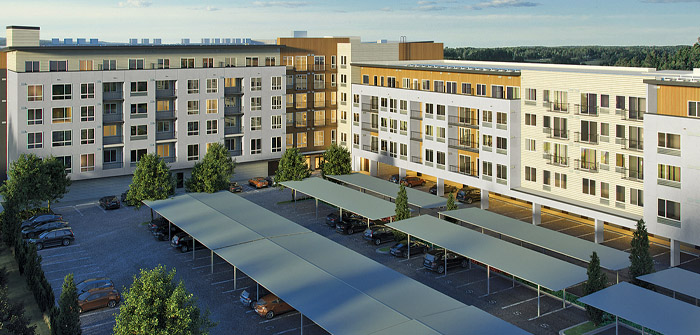(The Current’s combination of covered and tuck-under parking helps reduce the development’s contribution to Bend’s “heat island” effect | Rendering courtesy Horizon Realty Advisors)
The Current’s owner, Horizon Realty Advisors, challenged the project’s design team to deliver a mixed-use building designed with the environment in mind. Bend-based SĀJ Architecture delivered, creating a 202-residential-unit project that uses 15% less energy than Oregon energy code requires and provides much-needed housing close to outdoor recreation and within walking distance of shopping, restaurants, entertainment, and other services.
The 163,208-square-foot building’s name itself reflects a design theme focused on the project’s solar energy production, the energy created by a vibrant community, and the power of the nearby Deschutes River’s currents. The team is seeking U.S. Green Building Council LEED for Homes Gold Certification for the project, said The Current’s principal architect Seth Anderson, AIA, NCARB, LEED AP, of SĀJ Architecture.
“Buildings are responsible for an estimated 40% of energy use in the United States,” said Anderson, who in 2011 became one of the first architects in the nation to apply the International Green Construction Code (IgCC) to a project. “This gives architects a chance to do better for the environment and make a meaningful impact by reducing energy use when we design new buildings and update existing ones.”
Federal energy-use targets provide a powerful tool in reducing carbon emissions. Oregon seeks to further decrease building energy use by exceeding these national standards. This challenges architects and engineers in the state to find creative and cost-effective solutions to incorporate energy savings into their designs, Anderson said.
The Current features a 170-kW solar array, which will produce an estimated 250,000 kWh of electricity annually. “This is enough energy to power 100% of The Current’s lighting, cooling, elevators, and ventilation,” Anderson said.
In addition to producing energy, The Current also uses less energy than most housing. While Oregon’s goal for apartments is an energy use intensity (EUI) of 30, The Current comes in at just 21 EUIs. This savings is due in part to the building’s all-electric heat pump water heating (HPWH) system, Anderson said. Water heating accounts for 17-32% of a typical home’s energy usage, according to the U.S. Energy Information Administration. The Current’s system uses CO2 as a refrigerant, which allows it to operate much more efficiently than traditional systems.
The Current (located at 954 Emkay Drive) is also an example of using smart urban infill strategies to increase housing density and reduce vehicle trips. “When we build dense, environmentally friendly housing where people want to live, work, and play, we reduce each home’s environmental footprint and eliminate a lot of vehicle miles traveled,” said SĀJ Project Architect Brad Thomas, who is working on The Current. “We also avoid disrupting natural biomes for the construction of lower-density housing. By building this amount of density on a 2 ½-acre infill site in the heart of Bend, we’re eliminating the need to use 24-30 acres of undisturbed natural lands for single-family home construction.”
The Current features two-story walk-up units accessed from Emkay Drive, a first-of-its-kind design in Bend. This feature helps connect the building and residents to the street. The community includes a coffee shop; dog and bike “all-wash;” secure bike storage and ski/snowboard/gear repair station; fitness center; study and co-work lounges; and a rooftop common area, outdoor deck, and spa. A “green wall” in the lobby brings nature indoors, said SĀJ Interior Designer Emily Edmunds. “Bend residents are so active and involved with the outdoors, we wanted to bring that element to the interior space to create that connection.”
For its residents who use personal vehicles, The Current offers six electric vehicle charging stations. To better incorporate the building into its location, SĀJ took advantage of the sloping site to provide tuck-under parking that uses the building to shield street views of parked cars. This tuck-under parking, combined with additional covered parking, also reduces the development’s potential contribution to Bend’s “heat island” effect (the reflection of the sun’s heat by urban infrastructure that causes higher ambient temperatures relative to outlying areas). The Current is slated to open in June 2024. To learn more, visit TheCurrentBend.com.




